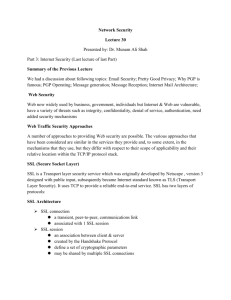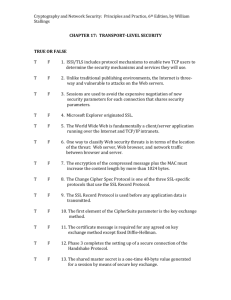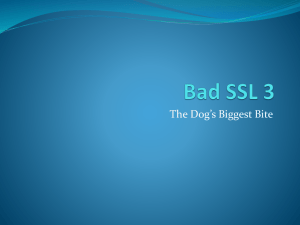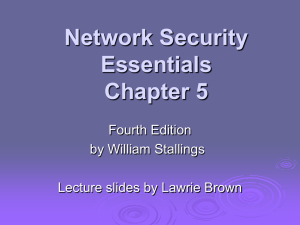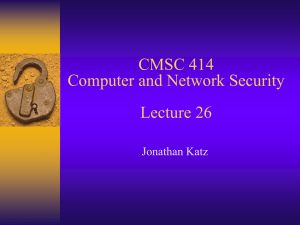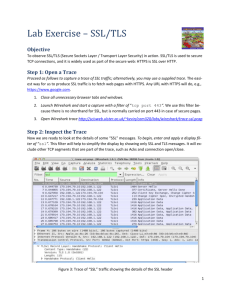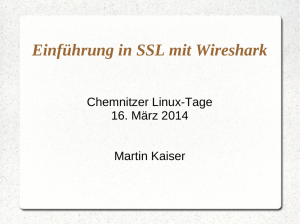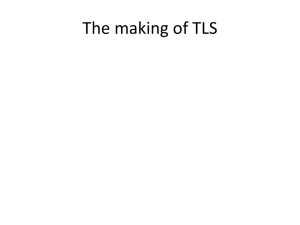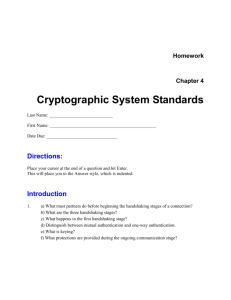Chapter 17
advertisement
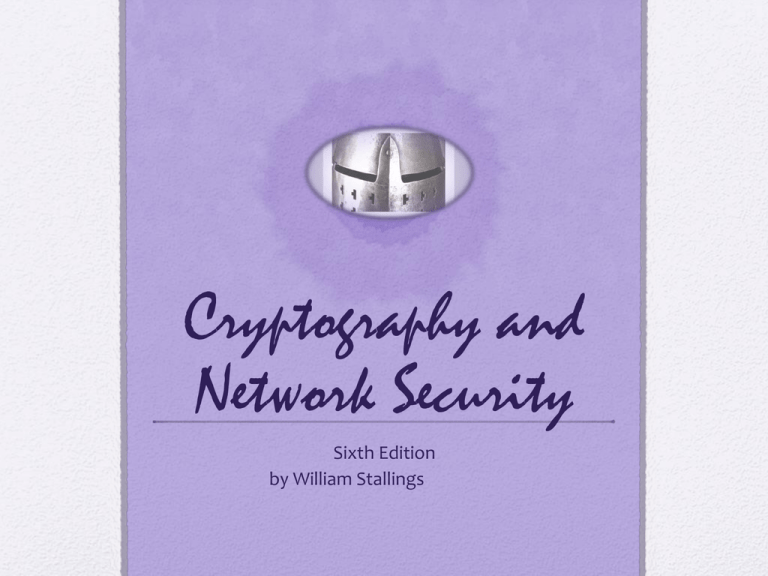
Cryptography and Network Security Sixth Edition by William Stallings Chapter 17 Transport-Level Security Use your mentality Wake up to reality —From the song, “I’ve Got You Under My Skin”, by Cole Porter Web Security Considerations • The World Wide Web is fundamentally a client/server application running over the Internet and TCP/IP intranets • The following characteristics of Web usage suggest the need for tailored security tools: • Web servers are relatively easy to configure and manage • Web content is increasingly easy to develop • The underlying software is extraordinarily complex • May hide many potential security flaws • A Web server can be exploited as a launching pad into the corporation’s or agency’s entire computer complex • Casual and untrained (in security matters) users are common clients for Web-based services • Such users are not necessarily aware of the security risks that exist and do not have the tools or knowledge to take effective countermeasures Table 17.1 A Comparison of Threats on the Web Secure Sockets Layer (SSL) • One of the most widely used security services • A general purpose service implemented as a set of protocols that rely on TCP • Could be provided as part of the underlying protocol suite and therefore be transparent to applications • Can be embedded in specific packages SSL Architecture • Two important SSL concepts are: SSL connection SSL session •A transport that provides a suitable type of service •For SSL such connections are peer-to-peer relationships •Connections are transient •Every connection is associated with one session •An association between a client and a server •Created by the Handshake Protocol •Define a set of cryptographic security parameters which can be shared among multiple connections •Are used to avoid the expensive negotiation of new security parameters for each connection A session state is defined by the following parameters: Session identifier An arbitrary byte sequence chosen by the server to identify an active or resumable session state Peer certificate An X509.v3 certificate of the peer; this element of the state may be null Compression method Cipher spec The algorithm used to compress data prior to encryption Specifies the bulk data encryption algorithm and a hash algorithm used for MAC calculation; also defines cryptographic attributes such as the hash_size Master secret Is resumable 48-byte secret shared between the client and the server A flag indicating whether the session can be used to initiate new connections A connection state is defined by the following parameters: Server and client random •Byte sequences that are chosen by the server and client for each connection Server write MAC secret •The secret key used in MAC operations on data sent by the server Client write MAC secret •The secret key used in MAC operations on data sent by the client Server write key Client write key •The secret encryption key for data encrypted by the server and decrypted by the client •The symmetric encryption key for data encrypted by the client and decrypted by the server Initialization vectors •When a block cipher in CBC mode is used, an initialization vector (IV) is maintained for each key •This field is first initialized by the SSL Handshake Protocol •The final ciphertext block from each record is preserved for use as the IV with the following record Sequence numbers •Each party maintains separate sequence numbers for transmitted and received messages for each connection •When a party sends or receives a change cipher spec message, the appropriate sequence number is set to zero •Sequence numbers may not exceed 264 - 1 SSL Record Protocol The SSL Record Protocol provides two services for SSL connections Confidentiality Message integrity The Handshake Protocol defines a shared secret key that is used for conventional encryption of SSL payloads The Handshake Protocol also defines a shared secret key that is used to form a message authentication code (MAC) Table 17.2 SSL Handshake Protocol Message Types Cryptographic Computations • Two further items are of interest: • The creation of a shared master secret by means of the key exchange • The shared master secret is a one-time 48-byte value generated for this session by means of secure key exchange • The generation of cryptographic parameters from the master secret • CipherSpecs require a client write MAC secret, a server write MAC secret, a client write key, a server write key, a client write IV, and a server write IV which are generated from the master secret in that order • These parameters are generated from the master secret by hashing the master secret into a sequence of secure bytes of sufficient length for all needed parameters Transport Layer Security (TLS) • An IETF standardization initiative whose goal is to produce an Internet standard version of SSL • Is defined as a Proposed Internet Standard in RFC 5246 • RFC 5246 is very similar to SSLv3 • Differences include: • • • • • • • • • Version number Message Authentication Code Pseudorandom function Alert keys Cipher suites Client certificate types Certificate_verify and Finished Messages Cryptographic computations Padding HTTPS (HTTP over SSL) • Refers to the combination of HTTP and SSL to implement secure communication between a Web browser and a Web server • The HTTPS capability is built into all modern Web browsers • A user of a Web browser will see URL addresses that begin with https:// rather than http:// • If HTTPS is specified, port 443 is used, which invokes SSL • Documented in RFC 2818, HTTP Over TLS • • There is no fundamental change in using HTTP over either SSL or TLS and both implementations are referred to as HTTPS When HTTPS is used, the following elements of the communication are encrypted: • • • • • URL of the requested document Contents of the document Contents of browser forms Cookies sent from browser to server and from server to browser Contents of HTTP header Connection Initiation For HTTPS, the agent acting as the HTTP client also acts as the TLS client The client initiates a connection to the server on the appropriate port and then sends the TLS ClientHello to begin the TLS handshake When the TLS handshake has finished, the client may then initiate the first HTTP request All HTTP data is to be sent as TLS application data There are three levels of awareness of a connection in HTTPS: At the HTTP level, an HTTP client requests a connection to an HTTP server by sending a connection request to the next lowest layer •Typically the next lowest layer is TCP, but is may also be TLS/SSL At the level of TLS, a session is established between a TLS client and a TLS server •This session can support one or more connections at any time A TLS request to establish a connection begins with the establishment of a TCP connection between the TCP entity on the client side and the TCP entity on the server side Connection Closure • An HTTP client or server can indicate the closing of a connection by including the line Connection: close in an HTTP record • The closure of an HTTPS connection requires that TLS close the connection with the peer TLS entity on the remote side, which will involve closing the underlying TCP connection • TLS implementations must initiate an exchange of closure alerts before closing a connection • A TLS implementation may, after sending a closure alert, close the connection without waiting for the peer to send its closure alert, generating an “incomplete close” • An unannounced TCP closure could be evidence of some sort of attack so the HTTPS client should issue some sort of security warning when this occurs Secure Shell (SSH) SSH client and server applications are widely available for most operating systems •Has become the method of choice for remote login and X tunneling •Is rapidly becoming one of the most pervasive applications for encryption technology outside of embedded systems SSH2 fixes a number of security flaws in the original scheme •Is documented as a proposed standard in IETF RFCs 4250 through 4256 A protocol for secure network communications designed to be relatively simple and inexpensive to implement The initial version, SSH1 was focused on providing a secure remote logon facility to replace TELNET and other remote logon schemes that provided no security SSH also provides a more general client/server capability and can be used for such network functions as file transfer and email Transport Layer Protocol • Server authentication occurs at the transport layer, based on the server possessing a public/private key pair • A server may have multiple host keys using multiple different asymmetric encryption algorithms • Multiple hosts may share the same host key • The server host key is used during key exchange to authenticate the identity of the host • RFC 4251 dictates two alternative trust models: • The client has a local database that associates each host name with the corresponding public host key • The host name-to-key association is certified by a trusted certification authority (CA); the client only knows the CA root key and can verify the validity of all host keys certified by accepted CAs Table 17.3 SSH Transport Layer Cryptographic Algorithms * = Required ** = Recommended Authentication Methods • Publickey • The client sends a message to the server that contains the client’s public key, with the message signed by the client’s private key • When the server receives this message, it checks whether the supplied key is acceptable for authentication and, if so, it checks whether the signature is correct • Password • The client sends a message containing a plaintext password, which is protected by encryption by the Transport Layer Protocol • Hostbased • Authentication is performed on the client’s host rather than the client itself • This method works by having the client send a signature created with the private key of the client host • Rather than directly verifying the user’s identity, the SSH server verifies the identity of the client host Connection Protocol • The SSH Connection Protocol runs on top of the SSH Transport Layer Protocol and assumes that a secure authentication connection is in use • The secure authentication connection, referred to as a tunnel, is used by the Connection Protocol to multiplex a number of logical channels • Channel mechanism • All types of communication using SSH are supported using separate channels • Either side may open a channel • For each channel, each side associates a unique channel number • Channels are flow controlled using a window mechanism • No data may be sent to a channel until a message is received to indicate that window space is available • The life of a channel progresses through three stages: opening a channel, data transfer, and closing a channel Channel Types Four channel types are recognized in the SSH Connection Protocol specification Session •The remote execution of a program •The program may be a shell, an application such as file transfer or e-mail, a system command, or some built-in subsystem •Once a session channel is opened, subsequent requests are used to start the remote program X11 •Refers to the X Window System, a computer software system and network protocol that provides a graphical user interface (GUI) for networked computers •X allows applications to run on a network server but to be displayed on a desktop machine Forwarded-tcpip •Remote port forwarding Direct-tcpip •Local port forwarding Port Forwarding • One of the most useful features of SSH • Provides the ability to convert any insecure TCP connection into a secure SSH connection (also referred to as SSH tunneling) • Incoming TCP traffic is delivered to the appropriate application on the basis of the port number (a port is an identifier of a user of TCP) • An application may employ multiple port numbers Summary • Web security considerations • Web security threats • Web traffic security approaches • Secure sockets layer • • • • • • SSL architecture SSL record protocol Change cipher spec protocol Alert protocol Handshake protocol Cryptographic computations • HTTPS • Connection initiation • Connection closure • Transport layer security • • • • • • • Version number Message authentication code Pseudorandom function Alert codes Cipher suites Client certificate types Certificate_verify and finished messages • Cryptographic computations • Padding • Secure shell (SSH) • Transport layer protocol • User authentication protocol • Communication protocol
